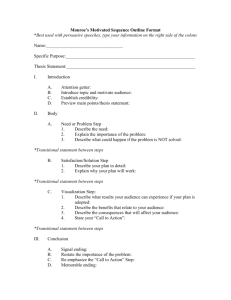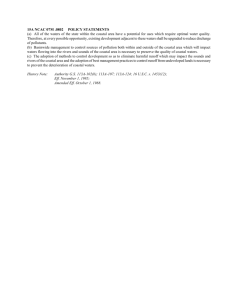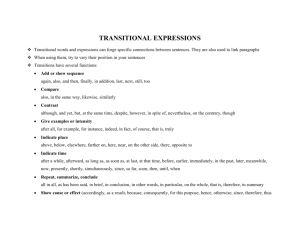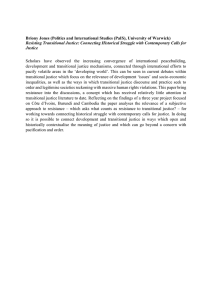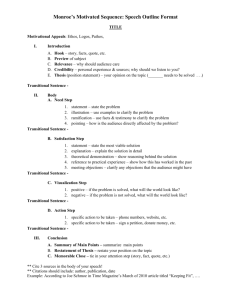ARTWEI – ACTION FOR THE REINFORCEMENT OF THE
advertisement
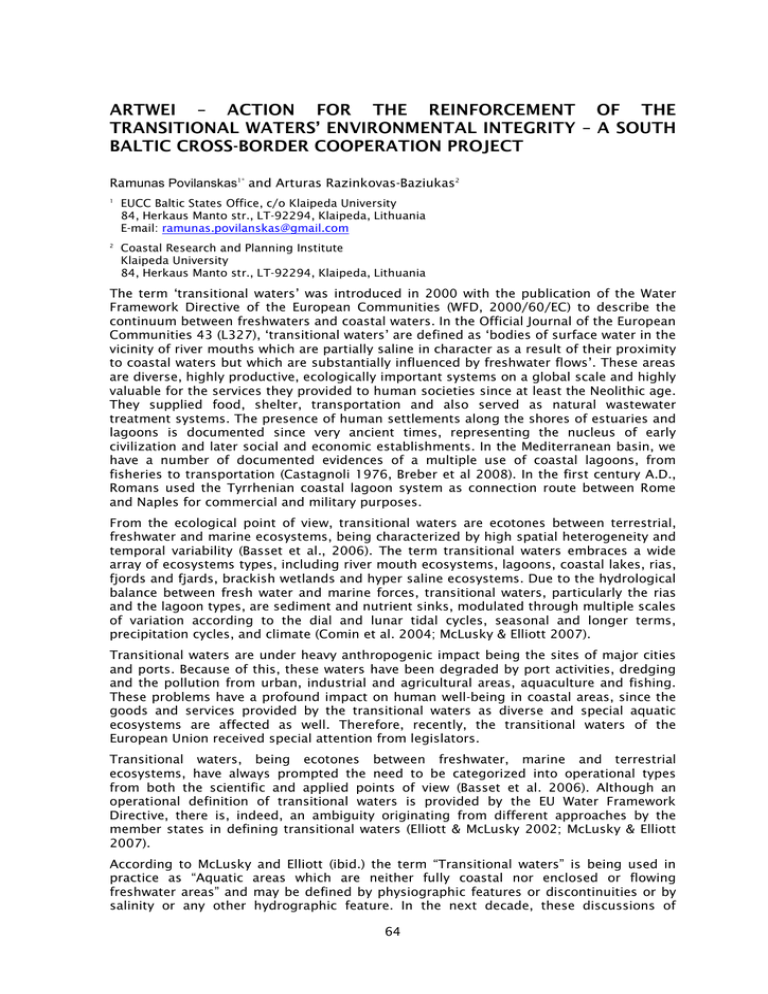
ARTWEI – ACTION FOR THE REINFORCEMENT OF THE TRANSITIONAL WATERS’ ENVIRONMENTAL INTEGRITY – A SOUTH BALTIC CROSS-BORDER COOPERATION PROJECT Ramunas Povilanskas1* and Arturas Razinkovas-Baziukas2 1 EUCC Baltic States Office, c/o Klaipeda University 84, Herkaus Manto str., LT-92294, Klaipeda, Lithuania E-mail: ramunas.povilanskas@gmail.com 2 Coastal Research and Planning Institute Klaipeda University 84, Herkaus Manto str., LT-92294, Klaipeda, Lithuania The term ‘transitional waters’ was introduced in 2000 with the publication of the Water Framework Directive of the European Communities (WFD, 2000/60/EC) to describe the continuum between freshwaters and coastal waters. In the Official Journal of the European Communities 43 (L327), ‘transitional waters’ are defined as ‘bodies of surface water in the vicinity of river mouths which are partially saline in character as a result of their proximity to coastal waters but which are substantially influenced by freshwater flows’. These areas are diverse, highly productive, ecologically important systems on a global scale and highly valuable for the services they provided to human societies since at least the Neolithic age. They supplied food, shelter, transportation and also served as natural wastewater treatment systems. The presence of human settlements along the shores of estuaries and lagoons is documented since very ancient times, representing the nucleus of early civilization and later social and economic establishments. In the Mediterranean basin, we have a number of documented evidences of a multiple use of coastal lagoons, from fisheries to transportation (Castagnoli 1976, Breber et al 2008). In the first century A.D., Romans used the Tyrrhenian coastal lagoon system as connection route between Rome and Naples for commercial and military purposes. From the ecological point of view, transitional waters are ecotones between terrestrial, freshwater and marine ecosystems, being characterized by high spatial heterogeneity and temporal variability (Basset et al., 2006). The term transitional waters embraces a wide array of ecosystems types, including river mouth ecosystems, lagoons, coastal lakes, rias, fjords and fjards, brackish wetlands and hyper saline ecosystems. Due to the hydrological balance between fresh water and marine forces, transitional waters, particularly the rias and the lagoon types, are sediment and nutrient sinks, modulated through multiple scales of variation according to the dial and lunar tidal cycles, seasonal and longer terms, precipitation cycles, and climate (Comin et al. 2004; McLusky & Elliott 2007). Transitional waters are under heavy anthropogenic impact being the sites of major cities and ports. Because of this, these waters have been degraded by port activities, dredging and the pollution from urban, industrial and agricultural areas, aquaculture and fishing. These problems have a profound impact on human well-being in coastal areas, since the goods and services provided by the transitional waters as diverse and special aquatic ecosystems are affected as well. Therefore, recently, the transitional waters of the European Union received special attention from legislators. Transitional waters, being ecotones between freshwater, marine and terrestrial ecosystems, have always prompted the need to be categorized into operational types from both the scientific and applied points of view (Basset et al. 2006). Although an operational definition of transitional waters is provided by the EU Water Framework Directive, there is, indeed, an ambiguity originating from different approaches by the member states in defining transitional waters (Elliott & McLusky 2002; McLusky & Elliott 2007). According to McLusky and Elliott (ibid.) the term “Transitional waters” is being used in practice as “Aquatic areas which are neither fully coastal nor enclosed or flowing freshwater areas” and may be defined by physiographic features or discontinuities or by salinity or any other hydrographic feature. In the next decade, these discussions of 64 habitat definition will become more important within Europe, given the implementation of the EU Water Framework Directive (WFD, 2000/60/EC) and also the limits of jurisdiction of the Marine Strategy Framework Directive (i.e. whether it will stop at the seaward limits of the transitional waters or whether it will go to the Tidal High Water mark inside estuaries and lagoons). This will require the member states to define the different types of transitional waters throughout Europe and to delineate the borders of these waters. The WFD is a wide-ranging and ambitious piece of European environmental legislation, which provides for a strengthened system for the protection and improvement of water quality and dependent ecosystems. The WFD process for identifying coastal and transitional water body types required the development of new approaches and the need to agree on a common set of typology factors (i.e. salinity, tidal range, exposure, etc.), and their categories for comparable and consistent typology categorization across the coastal areas of the regional seas. It was also acknowledged that the estuarine and coastal types are not distinct categories that can be easily identified by a set of factors, but rather a continuum. Therefore the borderline between two separate types has often been difficult to define (Borja et al. 2010). It is questioned whether estuaries and other transitional waters should be excluded from the MSFD if they have a large marine influence, e.g. tidal systems or where salinity incursion occurs as these by definition are part of marine systems. In their conclusion, Borja et al. (ibid.) emphasize that there is a need for a completely merged approach and a harmonized, seamless transition from catchment through transitional waters and coast to an open marine system. Despite the fact that the technical typology defined in the EU Water Framework Directive proved to be essential for defining a set of environmental descriptors and reinforcing environmental protection, the transitional waters are still a very complicated and often disguising term in this typology. This definition is even more problematic when applied to the three largest European transboundary lagoons situated in the Baltic region. The situation is especially complicated because two of these transitional water bodies are shared with the Russian Federation, which is not a part of the EU and, therefore, the term “transitional waters” has no legislative consequences in the Russian parts of the lagoons. The distribution of various types of transitional waters varies largely between different seas of Europe. Schernewski & Wielgat (2004) highlighted that each Baltic country has adopted a slightly different approach and some do not appear to be designating any transitional waters. In the Baltic Sea area, Finland and Estonia do not appear to have transitional waters, while in Sweden it was attempt to overcome problems in designating transitional waters by even suggesting a further category, that of enclosed, brackish coastal types. The North Sea and Baltic coasts of Denmark have no transitional waters. In Germany transitional waters were designated for its North Sea estuaries (the Weser, Elbe, etc.) but not for its Baltic Sea estuaries and lagoons. For example in the Odra lagoon, the Polish and German parts belong to different typologies (the Polish part being designated as transitional waters whereas the German part as coastal waters), which are confusing for both research and management matters. Lithuania considers the Curonian lagoon to be a transitional water body. Yet, the discharge plume from the Klaipeda Strait into the Baltic Sea is also designated as transitional waters. Latvia treats the Daugava River estuary and the riverine discharge plume into the Gulf of Riga as a transitional water area. Poland has designated as its transitional waters the entire areas of the Odra (Szczecin) Lagoon, Vistula Lagoon and a part of the Gulf of Gdansk (the inner Puck Bay) as well as parts of the Gulf of Gdansk and Pomeranian Bay where riverine plumes occur (Krzyminski et al. 2004). Poland has also designated the coastal areas affected by the riverine/lagoon plumes discharging into the open Baltic Sea as transitional waters. Transitional waters play a key role as spawning areas for fish and invertebrates and support a rich biodiversity and provide migration corridors for fish and waterfowl (Breber et al., 2008). They are often valuable natural heritages, are suited for human settlements and provide relevant biological resources, which are commercially exploited since the prehistorical times (Viaroli et al., 2005). A step backward in our history shows that the spatial 65 distribution of successful past societies was not random, but was rather the result of favorable ecosystem conditions, which, in turn, were determined by emergent properties at local and regional scales (ibid.). ARTWEI – Action for the Reinforcement of the Transitional Waters’ Environmental Integrity is a three-year transboundary cooperation project within the South Baltic Cross-border Cooperation Programme 2007 – 2013 of the European Union. The project aims to strike an operational balance between EU requirements for Maritime Spatial Planning framework, Water Framework Directive and Integrated Coastal Zone Management, which do often overlap or contradict each other. This aim is achieved by establishing the South Baltic Transitional Waters’ partnership network of the key institutions based on the long-term cooperation agreement and supported by the regional activity network of EUCC – The Coastal and Marine Union. Thus, the cross-border cooperation of local and regional interest groups, citizens and politicians is crucial. ARTWEI project has four cross-border transitional water regions of the South Baltic Area as target areas: Curonian Lagoon (LT/RU), Vistula Lagoon (RU/PL), Odra Lagoon (PL/DE), Oresund Sound (DK/SE). Concrete conclusions and recommendations for the durable reinforcement of the environmental integrity of the Transitional waters have been developed and politically endorsed in the form of a Good Practice Code of Conduct. A web-based multilingual platform, including webGIS and other ICT tools, are created facilitating an interactive knowledge exchange within and among Transitional Waters Stakeholder Bodies. Environmental education is an additional tool implemented in the form of a transboundary coastal dialogue, a photo competition and a public information system. References Basset A., Sabetta L, Fonnesu A., Mouillot D., Do Chi T., Viaroli P., Giordani G., Reizopoulou S., Abbiati M. & Carrada G.C. 2006. Typology in Mediterranean transitional waters: new challenges and perspectives. Aquatic Conservation: Marine and Freshwater Ecosystems 16: 441–455. Borja Á., Elliott M., Carstensen J., Heiskanen A.-S. & van de Bund W. 2010. Marine management – towards an integrated implementation of the European Marine Strategy Framework and the Water Framework Directives. Marine Pollution Bulletin, 60:12, 2175-2186. Breber P., Povilanskas R. & Armaitiene A. 2008. Recent evolution of fishery and land reclamation in Curonian and Lesina lagoons. Hydrobiologia 611: 105-114. Castagnoli F. 1974. La ‘carta archeologica d’Italia a gli studi di topografia antica. Quaderni dell ’Istituto di topografia antica della Universita di Roma, 6: 7-17. Comín F. A., Menéndez M. & Herrera J.A. 2004. Spatial and temporal scales for monitoring coastal aquatic ecosystems. Aquatic Conservation: Marine and Freshwater Ecosystems, Supplement: Monitoring Transitional Waters in Europe, 14: S5–S17. Elliott M. & McLusky D.S. 2002. The need for definitions in understanding estuaries. Estuarine, Coastal and Shelf Science 55, 815–827. Krzymiński W., Kruk-Dowgiałło L., Zawadzka-Kahlau E., Dubrawski R., Kamińska M. & ŁysiakPastuszak E. 2004. Typology of Polish marine waters. In: G. Schernewski & M. Wielgat (eds.): Baltic Sea Typology. Coastline Reports, 4: pp. 39-48. McLusky D.S. & Elliott M. 2007. Transitional waters: a new approach, semantics or just muddying the waters? Estuarine, Coastal & Shelf Science 71: 359–363. Schernewski G. & Wielgat M. 2004. Towards a Typology for the Baltic Sea. G. Schernewski & N. Löser (eds.): Managing the Baltic Sea. Coastline Reports 2, pp. 35–52. Viaroli P., Mistri M., Troussellier M., Guerzoni S. & Cardoso A.C. 2005. Structure, functions and ecosystem alterations in Southern European coastal lagoons. Preface. Hydrobiologia 550: vii–ix. 66


